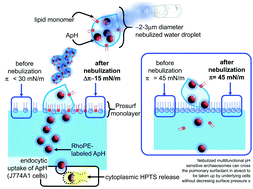Nebulizing novel multifunctional nanovesicles: the impact of macrophage-targeted-pH-sensitive archaeosomes on a pulmonary surfactant†
Abstract
In this study, a NE-U22 vibrating mesh Omron nebulizer was used to deliver the Lissamine™ rhodamine B 1,2-dihexadecanoyl-sn-glycero-3-phosphoethanolamine triethylammonium salt (Rh-PE) and 8-hydroxypyrene-1,3,6-trisulfonic acid trisodium salt (HPTS)/p-xylene-bis-pyridinium bromide (DPX) double-labelled macrophage-targeted pH-sensitive archaeosomes (ApH, 174 ± 48 nm, −30 ± 13 mV unilamellar nanovesicles made of dioleoyl-sn-glycero-3-phosphoethanolamine: [total polar archaeolipids from the hyperhalophile archaebacteria Halorubrum tebenquichense]: cholesteryl hemisuccinate 4.2 : 2.8 : 3 w : w : w) to J774A.1 cells covered by a Prosurf pulmonary surfactant (PS) monolayer at or below the equilibrium surface pressure πe. The uptake and cytoplasmic drug release from ApH were assessed by flow cytometry of Rh-PE and HPTS fluorescence, respectively. Despite being soft matter, nanovesicles are submitted to the dismantling interactions of shear stress of nebulization and contact with the surfactant barrier, and at least a fraction of nebulized ApH was found to be stable enough to execute higher cytoplasmic delivery than archaeolipid-lacking vesicles. Nebulized ApH increased the PS tensioactivity to just below πe, which was beyond the physiological range; this finding indicated that changes in lung surfactant function induced by nebulized nanovesicles were less likely to occur in vivo. The cytoplasmic delivery from ApH slightly decreased across monolayers at πe; this suggested that nanovesicles crossed the PS in a fashion inversely related to monolayer compression. Laurdan generalized polarization and fluorescence anisotropy were used to reveal that nanovesicles neither depleted B and C proteins of the PS nor increased the fluidity of the PS. Together with the feasibility of the cytoplasmic drug delivery upon nebulization, our results suggest that ApH are structurally unique nanovesicles that would not induce biophysical changes leading to PS inactivation and open the door to deeper future translational studies.



 Please wait while we load your content...
Please wait while we load your content...